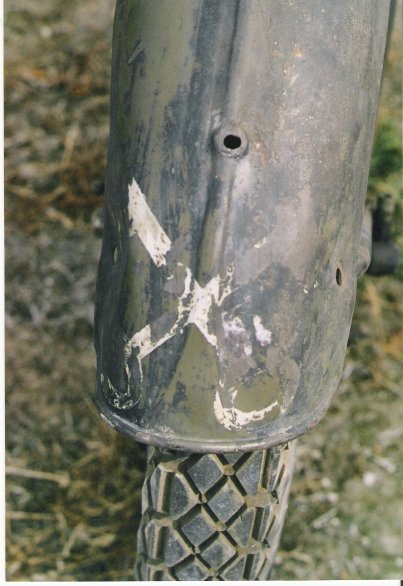|
The unrestored remains of a
WD16H surfaced in Belgium some
time ago. It is basically an original rolling chassis only, but it has parts
on it, which I have never seen on any other WD16H. The bike is from Contract C5109
(1939/1940), and sports the early type rear carrier, 7 1/2 inch
aperture DU142 headlamp, ribbed rear mudguard and rear number plate
fitted out with an MT110 rear light. Nuts and bolts were as new with regard to
nearly total absence of tool mark-off.
The
most likely explanation for this bike surfacing in Belgium is that it was part
of the British Expeditionary Force (BEF) which was stationed in
Northern France from September 1939 to June 1940, and ventured into Belgium on
May 10th 1940, after which it was driven from the
continent at Duinkerken (Dunkirk) by the advancing German Army. In this
timeframe, 21.081 motorcycles were transported from
UK to France (including 73 RAF motorcycles). Only 533 motorcycles returned to
the UK. This would indicate that more survivers could be around.
This bike shows damage from shell fragments in rear mudguard and rear tyre
which would have made it instantly unserviceable.
Apparently it was left behind by its rider, and possibly hidden from the
Germans for the rest of the war by some opportunistic Belgian. Somewhere in
its post military life, the bike was covered by a hand painted coat of matt black.
Why the drive train was removed will always be a mystery. A likely option may
be that it was removed by some farmer to be used as a mechanical power
unit for a pump or so. The engine was "surgically"
removed, all engine bolts replaced. Makes you wonder if somewhere, in a hidden
place there still is .....
The
tyres were marked as per November 1939 including the War Department
"broad arrow". They still wear coloured flags of the manufacturer
(Goodyear) and did not show much wear, indicating the very
limited use of this bike. The gash in the rear tyre could be lined up with the
hole in the front lower end of the rear mudguard.
Underneath
the black paint are still the markings of the British
2nd
Infantry Division (crossed keys) on front and rear mudguard and the Royal
Engineers arm of service colour (cobalt blue) on the rear number plate. The 1
denoting "Divisional HQ".
Also very remarkable was the dab of gas detection paint on the front of the
headlight. This is definitely yellow, but may have been a darker colour when
applied 60 years ago. The head lamp rim still has a Lucas paper identification
tag attached.
The bike has
been stored well in all those years of idling. It shows very little
rust for its age.
Another most interesting part of this bike was the electrical wiring and how it
was fixed to the frame. Based on the number of questions I shot at him, the owner cautiously
enquired "are you a wiring loom fetishist?". I must admit, I
was excited alright.
The wiring was rubber covered tin(?)
plated copper wires. More details are given in the Electric system section of
the website.
Spare parts lists do not mention
anything on the wiring loom or items like clips and even horn push buttons or
dipswitches.
The only not original part on the
bike was the handlebar. This had apparently been mounted to make the remains
of the bike
easier to handle.
Here a number of views of this
remarkable find! The owner wants to have it on the road again and is adding
period parts whenever he can find them.
Additional to this page, there is a chapter on some
interesting original parts
which surfaced recently and will be amended whenever something usefull is
found.
It seemed
a nice idea to follow the restoration of this bike. Rick Payne, the lucky
owner will keep us informed!
|

2nd
Division Crossed Keys. |

2nd Division Crossed Keys and Blue colour coded
rear number plate for Royal Engineers? |
|


Hole in front of rear mudguard and frame cross
member. |

Tyre manufacturing date, November 1939. |
|

MT110 rear light with cardboard blackout screen
reducing the lighting of the rear number plate.
|

Rear light mounting and wiring clip.
|
|

Terry saddle.
|

Wiring cable clips holding rubber covered wiring
loom.
|

Very neat cable lay out on switch and ammeter.
|

Top of headlamp showing the gas detection paint,
"reversed" switch lever and a domed ammeter glass!
|

Wiring remains and Ni Fe Voltage regulators found on the bike,
correct rear welded oil tank added later. Watch the yellow and white
paint still on the tyre after 60 years!
|

View showing rear light wiring clips, stays and rear carrier.
|

Rubber sheathing around top frame tube and wiring loom clips.
|

Bike as being rebuild using correctly dated parts as much as
possible.
|
|

